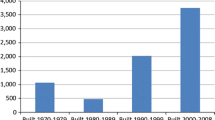Abstract
This model projects house values, rents, and incomes in small areas (planning areas, PA's); a subsequent procedure disaggregates these values, rents, and incomes to an even finer grain (transportation analysis zones, TAZ's). The model is part of a larger system in which demographic and econometric models provide aggregate control totals on increments of single- and multiple-family-dwelling units (SDU's and MDU's) and a series of spatial allocation models that distribute increments of SDU's and MDU's to TAZ's. Using probit analysis, the distributions of existing values, rents, and incomes are shifted upwards by estimated rates of appreciation. The increments of SDU's are distributed to value classes by a series of equations estimated by regression analysis on past County housing experience. The incomes associated with each value class are determined from a matrix of incomes by values derived from FHA experience. The increments of MDU's are distributed to rent groups as a function of the appreciated distribution of existing rents. The income distribution associated with each rent group is derived from a matrix of rents to incomes, developed from the 1970 Census. Finally, the increments are added to the existing to yield the projected PA distributions of rents, values, and incomes. In disaggregating, the following is done for each PA: An exogenously-determined matrix of projected incomes in the included TAZ's is iteratively adjusted to close to the marginal vector of projected PA incomes. Then, in each TAZ, the projected PA distribution of rents or values is shifted as the average income in the TAZ varies from the average income in the PA. This provides a matrix that is iteratively adjusted to close, first to the PA vector of values, then to the PA vector of rents. Although the model does not simulate market effects, it does provide a simple and plausible means of deriving short-term projections of house values, rents, and incomes.
Similar content being viewed by others
Author information
Authors and Affiliations
Additional information
The research and studies reported here were supported in part by grants from the Department of Housing and Urban Development. The author gratefully acknowledges the advice and assistance of Robert Goldman, Isao Kobashi and Paul Crable. Opinions expressed are those of the author and do not necessarily represent those of the County of Santa Clara, the Planning Policy Committee of Santa Clara County, or its sponsors.
Rights and permissions
About this article
Cite this article
Lockfeld, F.M. Short term projection of house values, rents and income for small areas: The Santa Clara County housing projection model. Ann Reg Sci 7, 47–66 (1973). https://doi.org/10.1007/BF01283483
Issue Date:
DOI: https://doi.org/10.1007/BF01283483




